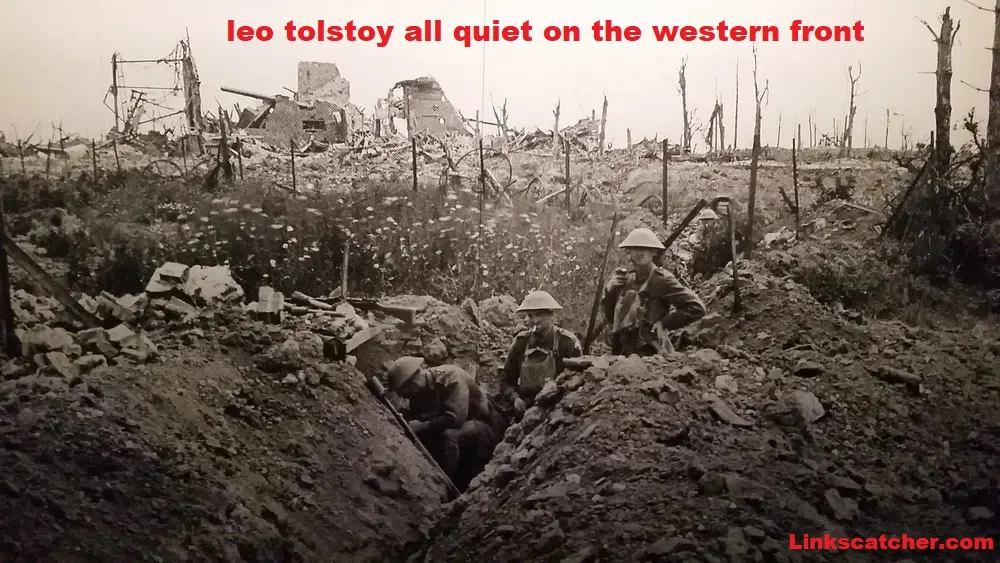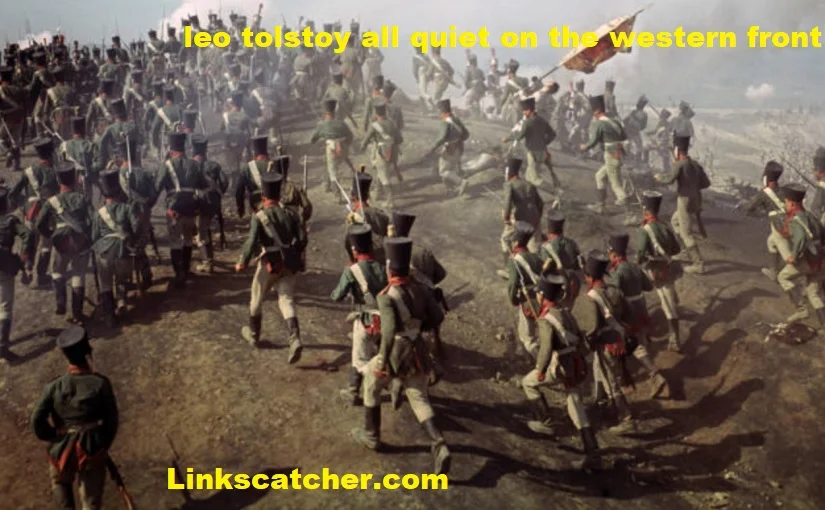
War has a way of revealing truths about humanity. leo tolstoy all quiet on the western front often misattributed to Leo Tolstoy, is actually penned by Erich Maria Remarque. This powerful novel uncovers the brutal realities faced by soldiers during World War I. It explores themes of friendship, alienation, and the devastating impact of war. Dive into this compelling exploration of conflict and its repercussions as we unravel its characters, plot, and broader significance in literature and history.
“All Quiet on the Western Front” brightly depicts the upsetting experience of soldiers. It captures their struggles, camaraderie, and the harsh truths of war, leaving readers to reflect on its profound emotional impact.
Introduction of Leo Tolstoy All Quiet On the Western Front
“leo tolstoy all quiet on the western front” often associated with Leo Tolstoy, is a powerful exploration of war’s brutal reality. This poignant narrative captures the emotional and physical toll experienced by soldiers during World War I.
About the author
Erich Maria Remarque, a German novelist and veteran of World War I, penned “All Quiet on the Western Front.” His experiences in battle deeply influenced his writing, capturing the harsh realities of war with poignant clarity.
Publication year
“leo tolstoy all quiet on the western front” was published in 1929. This poignant novel, written by Erich Maria Remarque, captures the harrowing experiences of soldiers during World War I and remains a powerful anti-war statement today.
Plot Summary
The novel follows Paul Bäumer, a young soldier who enlists with friends. As they face the horrors of World War I, their idealism crumbles amid relentless violence and loss on the Western Front.
Part I: Behind the Lines
In this section, soldiers grapple with the harsh realities of war. They face fear and uncertainty as they navigate life behind the lines, forming bonds that sustain them through trauma and relentless hardship.
Part II: On Leave
During leave, Paul struggles with the stark contrast between home comforts and battlefield horrors. He feels disconnected from family and friends, as their lives remain untouched by war’s grim realities. This deepens his internal conflict.
Part III: The Return to the Front
After a brief respite, Paul returns to the frontlines. The harsh realities of war await him. Familiar faces are missing, and the relentless violence reshapes his understanding of life and death in unimaginable ways.
Part IV: Conclusion
The novel’s haunting portrayal of war resonates deeply. It forces readers to confront the harsh realities faced by soldiers, leaving a lingering impact that prompts reflection on humanity and the consequences of conflict.
Characters of Leo Tolstoy All Quiet on the Western Front
The characters in “leo tolstoy all quiet on the western front” embody diverse perspectives. Each soldier, from Paul Bäumer to Müller, reveals unique struggles and insights that reflect the harrowing realities of war and its impact on humanity.
Paul Bäumer
Paul Bäumer is the novel’s protagonist. A young soldier, he grapples with the brutal realities of war. His journey reveals deep emotional scars and a profound loss of innocence amid the chaos of battle.
Lt. Bertinck
Lt. Bertinck embodies leadership and camaraderie. He cares deeply for his men, often providing guidance amid chaos. His character reveals the struggles of maintaining humanity in a brutal war, balancing duty with compassion.
Detering
Detering is a sensitive farmer, deeply connected to nature. His longing for the simple life contrasts sharply with the brutal realities of war. This inner conflict highlights his struggles and humanity amidst chaos.
Gérard Duval
Gérard Duval is a French soldier and printer. His tragic fate highlights the senselessness of war. Duval’s character embodies the shared humanity among soldiers, even amidst the chaos of battle on the Western Front.
Kantorek
Kantorek represents the older generation’s misguided patriotism. He pressures young men like Paul to enlist, romanticizing war without understanding its brutal reality. His character highlights the disconnection between ideals and the harsh truths of combat.
Stanislaus Katczinsky
Stanislaus Katczinsky, known as “Kat,” is a ingenious soldier and Paul’s adviser. His survival skills and wisdom bring hope to the group amidst despair, making him an essential figure in their wartime struggles.
Franz Kemmerich
Franz Kemmerich represents the tragic costs of war. A close friend to Paul, his suffering highlights the brutal reality of combat, evoking deep emotions and a sense of loss that resonates throughout the narrative.
Albert Kropp
Albert Kropp is a considerate soldier and Paul’s close friend. Known for his intelligence, he often questions authority and the war’s purpose. His perspective adds depth to the struggles faced by the soldiers on the front lines.
Müller
Müller is a pragmatic soldier, embodying the harsh realities of war. His focus on survival contrasts sharply with others’ idealism, emphasizing the struggle for basic needs amidst chaos and loss on the battlefield.
Paul’s mother
Paul’s mother embodies the pain of war. Her love for her son clashes with the harsh realities he faces. She represents hope and despair, highlighting the emotional toll on families during conflict.
Tiedjen
Tiedjen is a slight yet unforgettable nature in the story. His presence adds to the camaraderie among soldiers, illustrating how shared experiences can forge deep bonds, even amid the chaos of war and despair.
Tjaden
Tjaden, a fellow soldier, is known for his insatiable appetite and witty humor. His rebellious spirit contrasts sharply with the harsh realities of war. He embodies camaraderie amidst chaos, highlighting friendship’s importance in dire times.
Haie Westhus
Haie Westhus is a strong and resilient character, embodying the spirit of camaraderie among soldiers. His background as a peat digger shapes his perspective on war, highlighting both physical strength and emotional depth in battle.
Themes in Leo Tolstoy All Quiet On the Western Front

The themes in “leo tolstoy all quiet on the western front” explore individual versus machine, highlighting how war dehumanizes soldiers. Friendship emerges as a vital bond amidst chaos, while alienation and loneliness permeate their harrowing experiences.
Individual vs. Machine
The struggle between individuality and mechanization is central to the narrative. Soldiers become cogs in a vast war machine, losing their identity amid relentless violence, highlighting the profound dehumanization inherent in warfare.
Friendship
Friendship stands as a lifeline amidst the chaos of war. Bonds forged in shared suffering offer solace, strength, and humanity. These connections create a sense of belonging that transcends the brutality of the battlefield.
Alienation and Loneliness
Alienation and loneliness permeate the characters’ lives in “leo tolstoy all quiet on the western front.” Amidst camaraderie, profound isolation lingers, reflecting their inner struggles as they grapple with a world that feels increasingly distant.
Setting and Imagery
The stark imagery of war contrasts life before conflict. Desolate landscapes, mud-filled trenches, and shattered bodies paint a haunting picture. This vivid setting immerses readers in the raw reality faced by soldiers on the Western Front.
Point of view on Leo Tolstoy All Quiet on the Western Front
The novel employs a first-person narrative, immersing readers in Paul Bäumer’s thoughts and emotions. This perspective deepens the emotional impact, revealing the raw realities of war through his personal experiences and inner struggles.
Structure
The structure of “leo tolstoy all quiet on the western front” is linear, following Paul Bäumer’s journey. It interweaves vivid experiences with reflections, capturing both the chaos of war and profound emotional turmoil effectively.
World War I
World War I reshaped nations and ideologies. It introduced modern warfare, with trench battles inflicting profound psychological scars on soldiers. The conflict highlighted the brutal realities of war, forever altering perceptions of heroism and sacrifice.
War in the trenches
The trenches were a hellish landscape. Soldiers navigated mud, rats, and relentless shelling. Each day blurred into the next, marked by fear and camaraderie.
The Western Front
The Western Front was a brutal battleground during World War I, marked by trench warfare and relentless combat. Soldiers faced unimaginable conditions, often fighting for mere yards of territory amidst mud and despair.
The Human Cost of the War
The human cost of the war is staggering. Lives are lost, dreams shattered, and families torn apart. Each soldier’s story reveals pain, sacrifice, and the haunting scars that linger long after the battles end.
The Influence of the Older Generation
The older generation in “leo tolstoy all quiet on the western front” imposes their ideals on youth, pushing them to war. This mistaken power often leads to tragic penalty, highlighting a cut off between knowledge and the harsh realities of conflict.
Compare & Contrast with “War and Peace” by Leo Tolstoy
While “leo tolstoy all quiet on the western front” focuses on the brutal realities of World War I, “War and Peace” explores personal and historical narratives during Napoleon’s invasion. Both reveal deep human experiences amid conflict.
Critical Overview and Criticism
“leo tolstoy all quiet on the western front” has sparked extensive critical analysis. Scholars often explore its raw depiction of war, highlighting themes of trauma and disillusionment that resonate even today, making it a timeless literary masterpiece.
Media Adaptations
Films and miniseries explore the raw emotions of war, while recent Netflix versions provide a fresh perspective on Paul Bäumer’s poignant journey through battle.
Books Made into Movies
Several adaptations of “leo tolstoy all quiet on the western front” have emerged, capturing its harrowing essence. These films vividly portray the soldiers’ experiences, bringing Tolstoy’s themes to life through powerful visuals and stirring performances.
Books made into Netflix series or films
Numerous powerful novels have found a new life on Netflix. These adaptations often bring fresh perspectives to beloved stories, captivating audiences with visual storytelling while exploring themes that resonate across generations.
Sources and Further Study
For deeper insights into “leo tolstoy all quiet on the western front,” explore scholarly articles, biographies of Erich Maria Remarque, and critical essays. Documentaries about World War I also enhance understanding of the book’s historical context.
Additional titles of interest
Exploring the themes and characters in “leo tolstoy all quiet on the western front” opens doors to a deeper understanding of war literature. If you’re intrigued by these topics, consider delving into related titles like “The Things They Carried” by Tim O’Brien or “A Farewell to Arms” by Ernest Hemingway. Each offers unique perspectives on conflict and human experience.
For those drawn to Tolstoy’s broader works, “War and Peace” provides an epic view of life during tumultuous times. Additionally, “Anna Karenina” explores personal struggles amidst societal pressures.
These titles offer rich narratives that resonate with the profound truths found in the battlefields portrayed in Erich Maria Remarque’s classic novel. Happy reading!